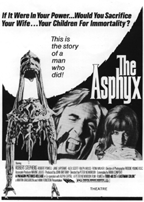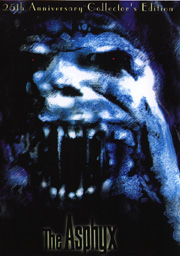| Release List | Reviews | Price Search | Shop | Newsletter | Forum | DVD Giveaways | Blu-Ray/ HD DVD | Advertise |
| Reviews & Columns |
|
Reviews DVD TV on DVD Blu-ray International DVDs Theatrical Reviews by Studio Video Games Features Collector Series DVDs Easter Egg Database Interviews DVD Talk TV DVD Talk Radio Feature Articles Columns Anime Talk DVD Savant HD Talk Horror DVDs Silent DVD
|
DVD Talk Forum |
|
|
| Resources |
|
DVD Price Search Customer Service #'s RCE Info Links |
|
Columns
|
 |
Savant Review:The Asphyx
|
||||
At the Dawn of DVD (circa March, 1997, soooo long ago) several bright new companies sprang up with disc releases that were anything but major studio product. One of these companies was All Day Entertainment, who started a special series of films so rare they were barely known on vhs, let alone laserdisc. At a time when the DVD shelves had fewer than a few hundred releases, there next to the Warner and MGM discs were titles like The Sadist and Ganja & Hess, and this weird chiller, The Asphyx. The Asphyx is a real aberration, a gothic horror film made in England in the early 70's that wasn't a direct attempt to emulate a Hammer shocker. Just when the Hammer horrors were turning to nudity and (belatedly) swingin' London foolishness in an attempt to bolster the faltering market for monster mayhem, out came this film with its high pedigree - top actors, lensed in a beautiful widescreen process by one of the best British cameraman of the sixties. Set in 1875, The Asphyx tells a tale of horror in pure Gothic mode: the woe that befalls a noble family when its patriarch crosses forbidden theological boundaries. Scientist - philanthropist Sir Hugo Cunningham (Robert Stephens) has been photographing dying men and recording a dark blur on his negatives that he boasts to his 'psychic society' is the image of the human soul leaving the body at death ... physical proof of the existence of the spirit world. He happens to be shooting motion pictures of his son and his fiancee just as an accident takes their lives ... and his movies record the blur as well. But the blur is moving toward the victims, not away from them, prompting Sir Hugo to alter his theory: the phenomenon recorded is not the soul, but a mythological spirit called The Asphyx, that appears only at the moment of death to claim the living. The Asphyx is seen more clearly at a public hanging. Sir Hugo uses a spotlight whose bright blue beam, created by water dripping on special crystals, seems to paralyze the hanged man's Asphyx and prevent it from reaching him. The dangling body shakes horribly until Sir Hugo shuts down his spotlight a few seconds later. Only then is the Asphyx free to perform its function, and the man dies. Realizing that if he can trap and hold an Asphyx, he can render its owner virtually immortal, Sir Hugo embarks on a morbid obsession. Driven by misplaced grief over the loss of his loved ones, he successfully 'immortalizes' a Guinea Pig. When an attempt to do the same with a dying, consumptive pauper fails, Sir Hugo makes a bargain with his partner, adopted son Giles (Robert Powell): if Giles helps immortalize him, Sir Hugo will do the same in turn with Giles and his fiancee, his own stepsister Christina (Jane Lapotaire). The Cunninghams will live forever and become masters of the world. There's only one catch: one's Asphyx only comes when a person is at the brink of death, in mortal danger and fearing for their life. So Sir Hugo starts building horrible electric chairs and guillotines in his basement laboratory ... The Asphyx is genuinely chilling. A morbid sense of dread hangs over the entire story, and the fact that the benevolent but misdirected Sir Hugo is no mad doctor makes the proceedings all the more unsettling. The Cunninghams are a very proper, liberal Victorian family with the strange curse of optimistic innocence - the very people whose good intentions pave that proverbial road to hell. Robert Stephens, famous for his role in Billy Wilder's The Private Life of Sherlock Holmes, captures both the exuberance and mania of an upperclass scientist who dares usurp the power of life and death. If Gothic Horror is 'about' families, as scholars claim, then The Asphyx is about Sir Hugo's abuse of his patriarchal authority, bullying his offspring into subscribing to his obsession. His adopted son Giles (Robert Powell) and daughter Christina (Jane Lapotaire, later famous for stage and screen portrayals of Edith Piaf) are played with compelling sincerity. We care about these privileged, foolish characters and have to watch helplessly while they threaten themselves in one unbearable immortality attempt after another. Very restrained direction by Peter Newbrook (mostly wide masters ) and immaculate Todd-AO 35 cinematography by Freddie Young create a convincing Victorian atmosphere, as does Bill McGuffie's beautiful romantic music. A modest production (it seems to use some familiar Hammer locations), The Asphyx can boast some very successful scenes. A boating picnic is reminiscent of Ken Russell's Women in Love. There's a convincingly brutal hanging, attended by a mixed mob of bloodthirsty sightseers and anti-death penalty protesters. Sir Hugo's lab is filled with the paraphernalia of death: coffins, cages and technological torture devices. Interestingly, the method of catching and imprisoning The Asphyx is almost identical to the 'proton packs' and 'laser containment grids' used to snag phantoms in Ghostbusters, twelve years later. The thematic problem in The Asphyx stems from the (in 1875) new art of photography. Some primitive cultures are said to believe that photographs 'trap the soul' in the same way Sir Hugo's photo light 'traps' mythological specters. Back in Victorian England, modern technology definitely was viewed as threatening the spiritual health of man. 
The Asphyx needs to be seen as if it were written and filmed in 1875; along with its Edgar Allan Poe - like morbidity, there's a certain naive plotting and a marked illogic to some of its contrivances. Sir Hugo has invented a movie camera twenty years too early, a strange anachronism. The morbid idea that a person could be prevented from dying, even if hanging with his neck broken, or worse, would seem to come from The Monkey's Paw (it also reminds of an undeveloped idea in Tod Browning's The Devil Doll) but isn't carried to its logical end - why isn't the night endured by the 'immortal' Sir Hugo, sealed Vampirelike in an airtight casket, spent gasping for air in excruciating torment? Why don't his brain cells die, leaving him an immortal vegetable? Likewise, some physical details need to be ignored: what are these incredible crystals that provide limitless perpetual phosphoresence? How 'eternal' can the Asphyx vault be, should the spring dry up or the plumbing give out? Especially when everything that could go wrong with all of Sir Hugo's previous inventions, does? Luckily, the appalling fascination with the grisly goings-on outweighs these strange, unnecessary non-sequitirs of logic. All Day's DVD of The Asphyx is a treasure of rarity. After twenty years of being told the film was totally unavailable, Savant finally saw a blurry pan 'n scan VHS tape (entitled Spirit of the Dead) that looked simply atrocious. This disc is handsomely letterboxed, with color that is very handsome but a mite faded. A reference book says The Asphyx was released in 'Quadrophonic magnetic sound' but this copy is a very healthy mono. The disc, particularly its first half, has several moments with a higher-than-normal look of artifacting. Savant is informed that there were only two surviving positive prints of the film, both scarred, and even mixing and matching scenes did not produce an unblemished copy. To make the few damaged moments play, Digital Video Noise Reduction (DVNR) was used, resulting in a few instances of digital distraction. This is a case of a film rescued from virtual extinction; The Asphyx actually plays very cleanly. There are a lot of fringe DVDs out there that should not go unheralded and The Asphyx is one of them. Surely a labor of love, All Day has once again done a major service to fans with this genuinely eerie, civilized tale of terror. This summer they're promising a series of German Mabuse films from the 1960s, starting with the incredibly rare German original version of Fritz Lang's last film, The 1,000 Eyes of Dr. Mabuse. Savant can't wait.
On a scale of Excellent, Good, Fair, and Poor,
The Asphyx rates:
DVD Savant Text © Copyright 1997-2001 Glenn Erickson
Review Staff | About DVD Talk | Newsletter Subscribe | Join DVD Talk Forum |
|
| Release List | Reviews | Price Search | Shop | SUBSCRIBE | Forum | DVD Giveaways | Blu-Ray/ HD DVD | Advertise |






